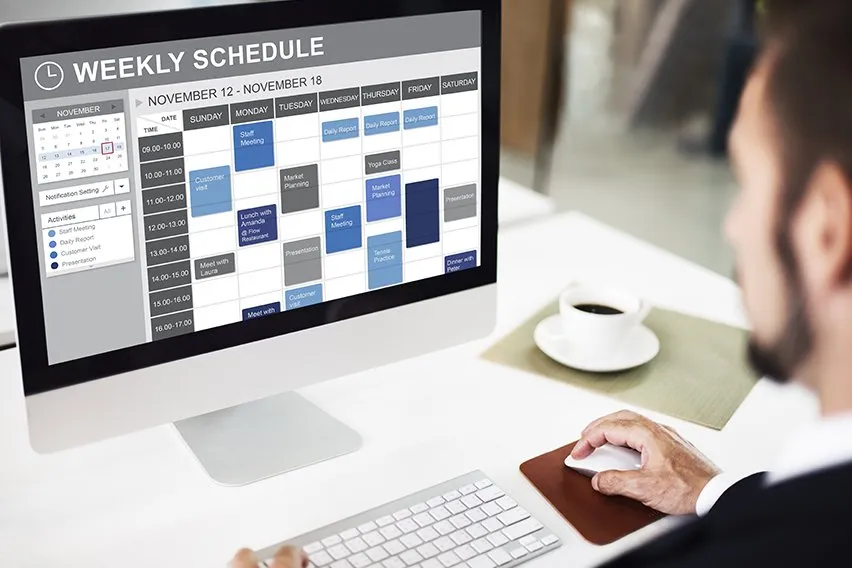11 Time Management Strategies

Time management refers to organizing your work hours so you can be more efficient with your time. There are many time management strategies that can help you boost workplace productivity, reduce procrastination, and minimize your stress.
We’ll explore the best time management strategies that you can apply to your daily routine. Learn strategies for goal-setting, planning, delegating, time tracking, and more, and find easy ways to apply these strategies at home and work.
Key Takeaways
- Good time management helps you increase efficiency and grow your business.
- Time management can help prevent burnout.
- Strategies for time management include planning, goal-setting, and minimizing distractions.
- Tools like time-tracking software can help you with your time management.
- Try different time management techniques to find what works best for you.
Table of Contents
- Define Your Goals
- Prepare a Plan
- Set Priorities
- Delegate Work
- Limit Distractions
- Keep Track of Time
- Stop Multitasking
- Practice Saying No
- Beat Procrastination
- Take Charge of Your Health
- Try Out Time Tracking Software
- Conclusion
1. Define Your Goals
Having clearly defined goals helps you and your team understand where to focus your time. Start by outlining major goals for your business, then break these down into smaller achievable goals. Make sure each goal has actionable steps and benchmarks that you can track.
Next, give your goals a timeline. For example, rather than saying “I want to grow my business,” set goals that include measurable elements like “I want to gain 50 customers in the next month” or “I want to bring in X amount in profits next quarter.” This type of actionable strategy makes it easier to tell how close you are to reaching your goal so you can identify anything that needs to be adjusted.
You should also try setting a mix of short and long-term goals. You can also break long-term goals into shorter pieces—this helps you stay on track and gives you something to celebrate when you reach your goals along the way.

2. Prepare a Plan
When you’re confronted with a big task, one question can stand in the way of productivity: “Where do I start?” Whether you’re creating a vision for your business or setting up specific tasks for your day, a clear plan saves you from facing indecision so you can get straight to accomplishing your goals.
Start by outlining what you want to achieve and creating a basic timeline. Break that down further into weekly objectives and make a list of the steps needed to achieve each goal.
These actionable steps provide the basis for your plan. From there, you can decide how you want to tackle each step—consider creating a daily to-do list with clear goals, so you have a straightforward way to work on your plan every day.
3. Set Priorities
Even with a good to-do list, it’s easy for a heavy workload to feel overwhelming. Instead of facing your workload as a whole, set priority tasks for each day, week, and month.
A good place to start is by picking 3 priorities for each day. You can adjust this as needed to tailor your time management strategy, but it’s important to keep your priority list manageable.
Divide tasks based on their urgency and importance. Not all urgent tasks are also important tasks—for example, replying to emails that aren’t related to essential tasks. By categorizing tasks as important, urgent, both, and neither, it’s easier to separate the tasks that need to be done today from non-essential tasks that can wait until you have a bit more flexibility.
If you have tasks that are both urgent and important, put them at the top of your daily tasks to-do list. Tasks that are just urgent or important can be added to your weekly priority list.
4. Delegate Work
Although it may feel tempting to manage everything yourself, delegating work can help free up your time so you can focus on the tasks that require your personal attention. Delegation is one of the best time management strategies for managers.
Begin by going through your to-do list and setting aside any tasks that need to be done personally. With the remaining tasks, assess the skills and experience required to do a good job, then match each task with the appropriate team member.
Communication is key when delegating work—make sure to clearly outline your expectations and timelines. Depending on the person, you may also describe steps to complete the task. However, you may not need to do this for everyone—allowing a certain amount of freedom and creativity can build employees’ confidence and boost productivity.
Check in from time to time, but try not to micromanage. Instead, take the newly freed time to tackle the big tasks on your to-do list so you and your team can operate at maximum productivity.
5. Limit Distractions
With digital devices on hand, it’s easier than ever to get distracted. Consider how you can create physical and digital distraction-free zones to boost focus while you work.
Physical Distractions
If you work in an office, it can be helpful to have designated ‘closed-door’ hours. Let your team know that you’re available for anything urgent, but ask that they pause non-urgent business and socializing during the set time.
If you work from home, try to set aside a specific space that’s just for work. Try to set up a desk somewhere that’s away from non-work screens like TVs to help build the mindset that while you’re in this area, you’re committed to work.
Digital Distractions
Digital distractions can be challenging because it’s often essential to be on your phone and computer for work. It’s easy to get drawn into checking emails, news, and other things that can feel productive but aren’t actually tackling your to-do list.
Fortunately, several techniques can minimize digital distraction. Timer apps like Forest encourage you to avoid looking at your phone for a set amount of time. Distraction-free browsers and plug-ins can minimize pop-ups and silence notifications so you can stay focused while you work on the computer.
6. Keep Track of Time
Understanding how you spend your time is the first step to spending it more effectively. Time tracking software is a great way to keep track of how much time you spend on each part of your work so you can figure out where you need to improve.
It’s a good idea to track time for different projects and tasks, and then compare that with related profits. You may discover that some tasks take up too much time and don’t turn over a great profit—this helps you decide what you want to take on in the future.
Time tracking is also an important task for billing clients, making your software a good 2-for-1 productivity tool. Browse the best time tracking software to find the right fit for your needs.
7. Stop Multitasking
It can be tempting to multitask because it feels efficient, but studies have shown that it often has the opposite effect: Multitasking forces your brain to switch between different jobs, reducing concentration and focus.
Ditch the multitasking and focus on one thing at a time to increase your productivity. Try to work on one task until you’re finished, then move on to the next. If you find one task feels like a block, complete the other tasks first and come back to that one at the end, rather than jumping back and forth.
8. Practice Saying No
Saying yes to everything isn’t just about people-pleasing—it can often come from a desire to not miss out on opportunities. While this instinct is good for a business mindset, saying yes to everything can lead to burnout.
When considering whether to say yes or no, it helps to have a list of questions to ask yourself. Develop these to suit your own goals, but some good starting questions may include:
- Does this task move me toward my goals?
- How much time will this take and could that time be better used on something else?
- What are the consequences of saying no?
- Is this opportunity likely to come up again?
- Do I have the energy to do this task well without risking burnout?
In many cases, what feels like a pressing opportunity isn’t actually urgent. Saying no to less important things frees up your time and energy to focus on your goals and gives you the scope to say yes to the things that matter most.
9. Beat Procrastination
Procrastination is often about the challenge of starting. It’s tempting to leave daunting tasks to the end, so approaching them from an opposite mindset and tackling unpleasant or challenging tasks at first helps build a habit of beating procrastination.
Try setting a specific time, ideally early in the day, when you’ll start the task. Set a timer and work only on that task until the timer runs out. Often, once you’ve begun the task, you’ll find you can work beyond the timer and complete the task in less time because you’ve surpassed the hurdle of starting.
Another strategy is to break the task into manageable components and tackle each one separately. This also reduces the starting burden and makes the larger project feel more attainable.
10. Take Charge of Your Health
When you’re focused on working, it’s easy to let things like personal health take second place. However, keeping yourself healthy is key to working effectively and maintaining your productivity and happiness in the long run.
Set aside some time every day for exercise. Especially if you work at a desk, giving yourself a 30-minute break to take a walk helps clear your mind and boost your energy. It’s also a great time to think over problems—in many cases, great ideas come when you’re not working.
Create a sleep schedule and stick to it. If you have a large project that requires you to work overtime, try to block off a few days afterward to reset your sleep schedule and get back on track. Even if it’s difficult at first, sleep and exercise are about building a routine, so eventually, they become healthy and energizing habits.
11. Try Out Time Tracking Software
Time management isn’t something you have to do all by yourself—there are plenty of great tools that can support you. Apps and software can help you reduce distractions, organize your goals, understand how you spend your time, and streamline work-life balance and productivity.
Try out different software to see what works for you. FreshBooks time tracking software is a great option for time management and makes it easy to keep track of how much time you spend on each task. Track time for productivity and billing with one easy software for all your time and project management needs.
What Are Time Management Techniques?
Time management techniques are strategies to help you increase efficiency and make the most of your work hours. These can include planning techniques to help you prioritize tasks, strategies to reduce distraction, and time tracking to help you understand how to use your work time.
Explore more about how the right skills can help you improve your business in this informative article on time management techniques.
Why Is Time Management Important?
Successful time management is key to producing great work and sustainably growing your business. It also helps to prevent burnout so you can take advantage of great opportunities when they arise. There are many benefits to using core time management skills, including:
- Producing better work
- Expanding the amount of work your team can manage
- Meeting your deadlines
- Minimizing stress
- Creating sustainable work habits
Learn more about the importance of time management and how it can help you grow your business.

Conclusion
Learning how to manage your time effectively can help you increase your efficiency, meet your deadlines, and grow your business. It’s also an important technique for reducing stress and boosting confidence so you can create sustainable growth.
There are a variety of effective time management strategies that can help you, including planning, delegating, prioritizing tasks, and limiting distractions. You can also use tools like time tracking software to help you with your time management. Try different time management techniques so you can find the strategies that fit your work style.
Reviewed by
Sandra Habiger is a Chartered Professional Accountant with a Bachelor’s Degree in Business Administration from the University of Washington. Sandra’s areas of focus include advising real estate agents, brokers, and investors. She supports small businesses in growing to their first six figures and beyond. Alongside her accounting practice, Sandra is a Money and Life Coach for women in business.
RELATED ARTICLES



 How to Make a Business Plan: A Comprehensive Guide
How to Make a Business Plan: A Comprehensive Guide The 5 Best Free Online Planners
The 5 Best Free Online Planners 6 Best Free Timeline Makers
6 Best Free Timeline Makers 8 Best Inventory Management Software for Small Businesses
8 Best Inventory Management Software for Small Businesses Inventory Management System – Complete Guide
Inventory Management System – Complete Guide What is ERP (Enterprise Resource Planning)?
What is ERP (Enterprise Resource Planning)?